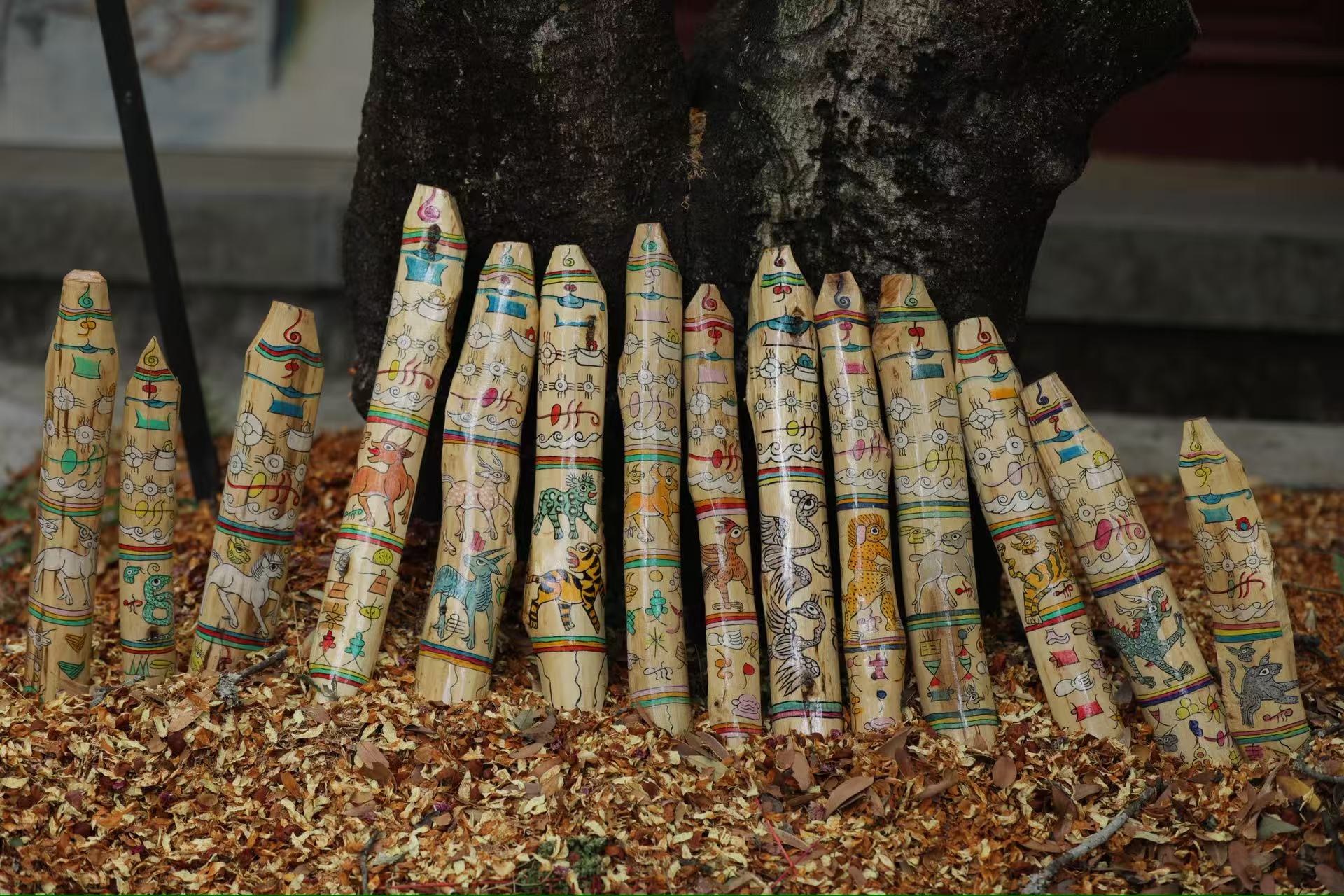High in the Himalayas, where Yunnan’s misty mountains cradle ancient villages, the Naxi people have woven a cultural fabric unlike any other. At its heart lies Dongba culture—a living, breathing tapestry of symbols, stories, and communal wisdom that has shaped daily life for over a millennium. Forget sterile museum exhibits; here, pictographs leap from ritual texts onto street signs, coffee shop murals, and the weathered hands of elders teaching children to trace the curve of a bird’s wing or the ripple of a stream. This is a world where writing isn’t just recorded—it’s performed, sung, and danced into being710.
The star of this cultural symphony is Dongba script, the world’s only living pictographic writing system. Known as “Sijiu Lujiu” (wood’s trace and stone’s mark), it captures life with startling immediacy: draw a mountain to speak of mountains, sketch a fish to evoke rivers. With over 1,400 glyphs, it can narrate epic poems like The Romance of Luban Lurao, lament lost loves, or even draft shopping lists. Unlike static hieroglyphs, Dongba script pulses with adaptability. When new ideas arrived—a Buddhist concept, a technological tool—Naxi scribes didn’t borrow words; they crafted fresh pictographs, absorbing change while keeping their visual language rooted5810.
This openness defines Dongba culture. Walk into an ancient temple in Lijiang, and you’ll see Tibetan Buddhist deities sharing walls with Taoist immortals and Dongba nature spirits. A Dongba priest’s tools reveal centuries of dialogue: a five-pointed crown from Han Chinese Buddhism, a bell from Tibetan rituals, and bone charms whispering of older, animist roots. Even the revered “Eight Auspicious Symbols” blend imported motifs like the lotus with local emblems like the moon and sacred pearls. It’s not syncretism—it’s a conversation, where traditions meet without erasing each other710.
Beyond symbols, Dongba wisdom permeates how people live. Take Dongba paper, crafted from poisonous Rao tree bark. Villagers like He Zhiben’s family brave swollen faces and eye infections to harvest it, relying on herbal antidotes (“Shaoqi”) to survive. Why endure this? The resulting paper is impervious to insects and time, preserving texts for centuries. It’s a metaphor for Naxi resilience: sacrifice for endurance, pain for permanence1. Similarly, the iconic Naxi women’s dress—adorned with seven embroidered discs—tells a story of balance. “Shouldering the sun and moon, bearing the stars,” it honors women’s labor while embodying harmony with nature’s cycles10.
But culture lives through people, not artifacts. Dongba masters (Dongbas) are more than priests—they’re living libraries, healers, artists, and community anchors. Yang Duoji in Yumi village translates ancient scriptures; Shi Maning guards origin myths passed down from his grandfather. Their training is grueling: nights hunched by pine-torch light, tracing glyphs until a master’s gaze (sharp as an eagle’s) signals approval. When young apprentices like Shi Maning left for city jobs, a letter recalling their cultural duty—“Without this, we lose our soul”—brought them home. This isn’t blind tradition; it’s a conscious choice to carry identity in a globalized world39.
Modernity, of course, tests this continuity. As roads reach remote villages like Yumi, youth migrate for work, leaving fewer to learn the glyphs and dances. Some rituals survive only in digital recordings. Yet innovation fuels revival. At the Jade Dragon Dongba Culture Academy, founded by the 17th-generation Dongba Ah Heng Dongta and writer Lan Xin, ancient texts become digital archives and best-selling literature. Here, Lan Xin—breaking centuries of gender barriers as the first female Dongba heir (“Lan Xin Samei”)—uses social media to turn rituals into global storytelling6. Meanwhile, projects like the World Memory Heritage digital platform unite scholars from Zurich to Beijing, transforming manuscripts into interactive apps while villagers in Sanba contribute oral histories29.
Dongba culture thrives precisely because it refuses to be frozen in time. It’s a dynamic dance between mountain and metropolis, ink and pixel, elder and child. In Lijiang’s bustling markets, you’ll find Dongba pictographs on artisanal paper (*“10 yuan a sheet, bearing tree-bark texture”*)110, but also emblazoned on trendy totes. When UNESCO celebrated Chinese Language Day in 2021, it featured a Dongba master lecturing via livestream—ancient symbols flickering across global screens6. This is cultural resilience: not a fortress against change, but a river that absorbs tributaries yet flows unbroken. As one Naxi elder told researchers while grinding herbs for papermaking: “Culture vanished is a sin. We carry it so our children know where their soul lives.”39. In every glyph, song, and hand-pulled sheet of paper, that living memory endures.
Blog posts

In the mist-shrouded peaks of Yunnan’s Himalayan foothills, where the Naxi people have woven spirituality into the fabric of daily life for over a millennium, two divine beings anchor a cosmic dram...

4. Symbolic Philosophy Animistic Connection: Trees embody "Shv" — nature spirits that govern mountains, forests, and water. Dongba Cosmology: Wood acts as a bridge linking the Three Rea...

High in the Himalayas, where Yunnan’s misty mountains cradle ancient villages, the Naxi people have woven a cultural fabric unlike any other. At its heart lies Dongba culture—a living, breathing ta...
We'd love to hear from you
If you have any questions, please fill in this contact form, and our team will reach you back as soon as possible.

Leave a comment
This site is protected by hCaptcha and the hCaptcha Privacy Policy and Terms of Service apply.